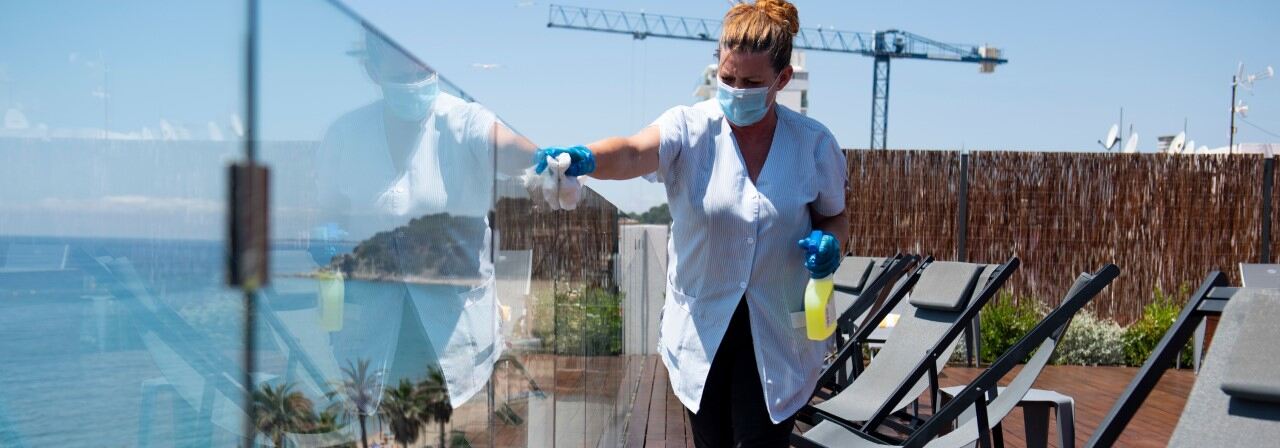Hotels plan for a COVID-19-informed future
The next normal will include safety ratings and cleanliness councils
The coronavirus pandemic has roiled the hospitality industry, closing more than 5,000 hotels in the U.S. alone in March and April.
By the start of June, nearly half were still shuttered, according to STR, a hotel data provider.
Now, after months of lockdowns and travel restrictions, some parts of the world are slowly starting to reopen to international travelers. In other areas, regional travel is beginning in earnest. But in a world still grappling with the pandemic, it’s far from business as usual. Hotels are transforming their cleaning protocols and operating models based on the needs of an unprecedentedly germ-conscious public.
“For many people now, the ideal hotel stay involves far less human interaction — pristine and visibly clean,” says Geraldine Guichardo, Global Head of Research, Hotels & Hospitality Group, JLL. “That’s what people will be expecting.”
Global hotel groups have announced sweeping safety measures including electrostatic sprayers to sanitize surfaces, partnerships with disinfectant brands, and partnerships with health care experts to design new guidelines and protocols.
Marriott International launched its Global Cleanliness Council in April and announced investment in sanitation technology. Hilton has aligned with RB, the maker of Lysol and Dettol products, and is consulting with the Mayo Clinic on cleaning practices in all its properties, branded as its CleanStay program.
In Europe, Wyndham Hotels and Resorts extended its Count on Us initiative focused on enhancing safety procedures, including the use of top-of-the-range disinfectants and ongoing access to critical health essentials.
Industry associations are also weighing in. The American Hotel & Lodging Association in May announced its Safe Stay industry-wide cleaning guidelines — calling for procedures such as the frequent cleaning of high-touch surfaces and sneeze- and cough-guards on buffets. The guidelines have been endorsed by hospitality groups across North America, such as Associated Luxury Hotels International and the Global Business Travel Association.
These shifts show that sanitation practices that were acceptable pre-pandemic will no longer be good enough, and hotels will be required to shift their operating models to afford these new standards, says Andrea Grigg, Managing Director, Asset Management, Hotels & Hospitality Group, JLL, who leads asset management for the Americas.
“Cleanliness ratings are likely to become the new key standard for hotels and will replace outdated brand standards,” she says.
Indeed, many of these changes are not just in place for the immediate re-opening stages. Rather, they represent longer-term shifts in operating models as owners and operators look toward a future shaped by the coronavirus pandemic.
Looking for more insights? Never miss an update.
The latest news, insights and opportunities from global commercial real estate markets straight to your inbox.
“Guests are likely to look for reassurance that health precautions are in place for the medium to long-term as the psychological impacts of the pandemic outlast the virus,” says Jessica Jahns, Head of EMEA Hotels & Hospitality Research. “This may shift preferences to trusted brands over independent properties or sharing economy accommodations such as Airbnb, as consumers trust the brand standards.”
The road to recovery
In the U.S. alone, COVID-19 cost the travel industry US$176 billion in cumulative losses from early March to May 16, according to the U.S. Travel Association.
U.S. hotel occupancy levels shrank to less than 25% in April, down 64% from a year ago, in what STR called the “worst single month ever.”
How quickly hotels recover will depend largely on the travel industry itself — namely whether people are willing to fly, says Daniel Fenton, Director of Global Tourism and Destination Development Services, Hotels & Hospitality Group, JLL.
“The first round of leisure travelers will be inclined to drive rather than fly,” he says. “After that, individual business travel will start to grow, followed by group business travel. It will take longer for group leisure travel.”
With this extended timeline, the ongoing forecasting uncertainty and reinforced social distancing measures, some hotels may find themselves unable to justify the cost of re-opening, says Wendy Chan, Senior Vice President, Hotels & Hospitality Group, JLL, who leads advisory throughout Latin America. This conclusion has pushed hotel investors and operators to consider temporary-use or conversion opportunities to other real estate uses such as coworking spaces, multifamily, senior living, and student housing, she says.
Investment Opportunities
For parts of the world that are especially reliant on tourism, recovery can’t come fast enough. Mexico typically reports an average of 40 million tourists a year, making it the most popular destination in Latin America. The country registered close to 80% fewer international tourists in April than in the same month of 2019, according to the National Institute of Statistics and Geography (INEGI).
How quickly the country recovers is largely dependent on economic recovery in the U.S. and Canada, the two most prominent international sources of visitors to Mexico.
“Everything depends on how quickly global markets recover, when a vaccine is approved and distributed, and when people have the disposable income and confidence to travel,” Chan says. “In the meantime, the hotel industry is in the process of rethinking the business.”
Contact Geraldine Guichardo
Global Head of Research, Hotels & Hospitality Group, JLLWhat’s your investment ambition?
Uncover opportunities and capital sources all over the world and discover how we can help you achieve your investment goals.
